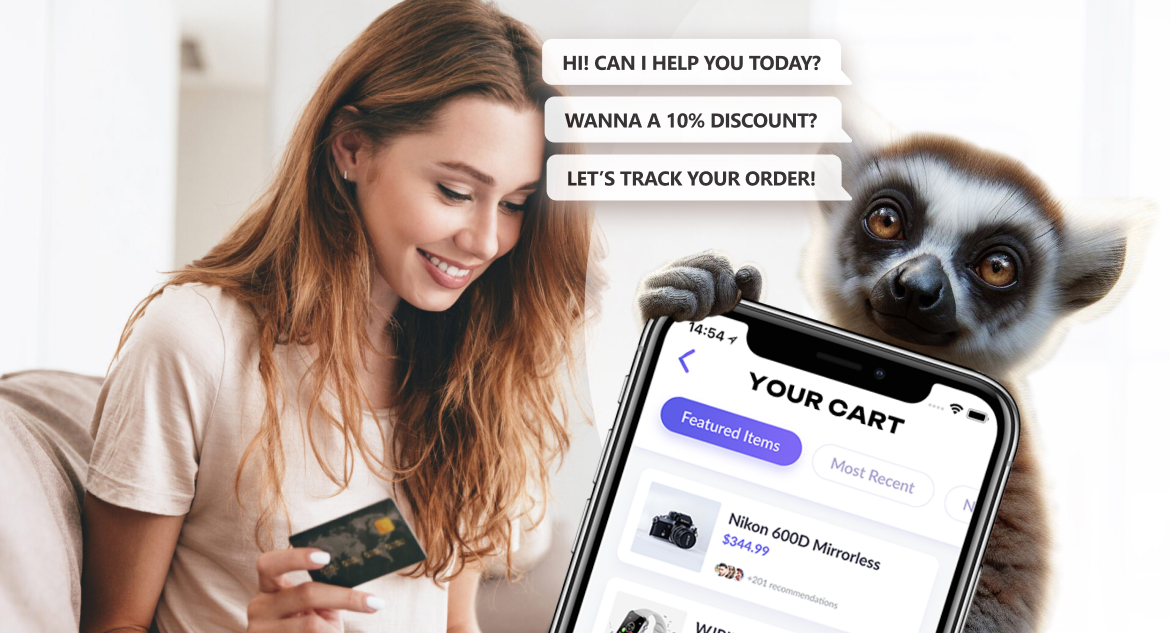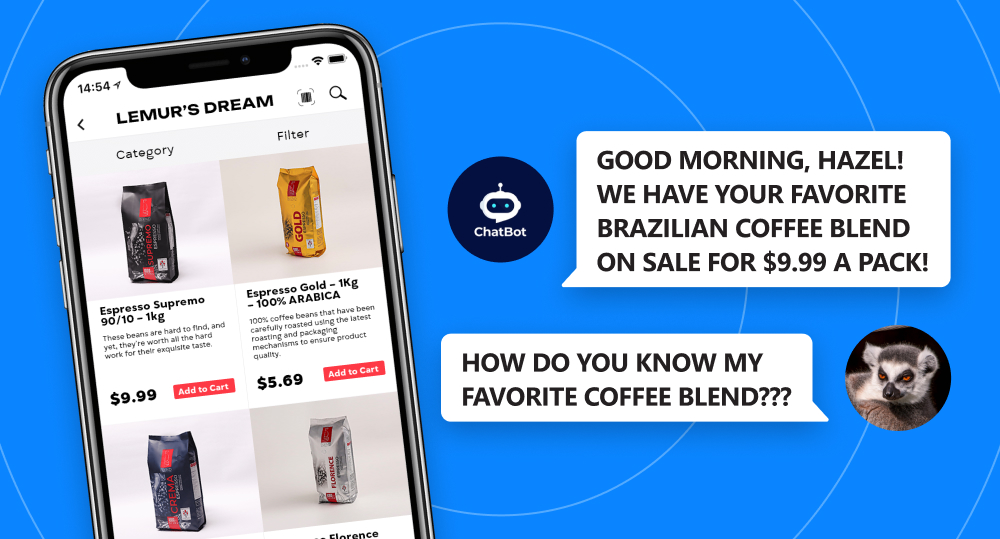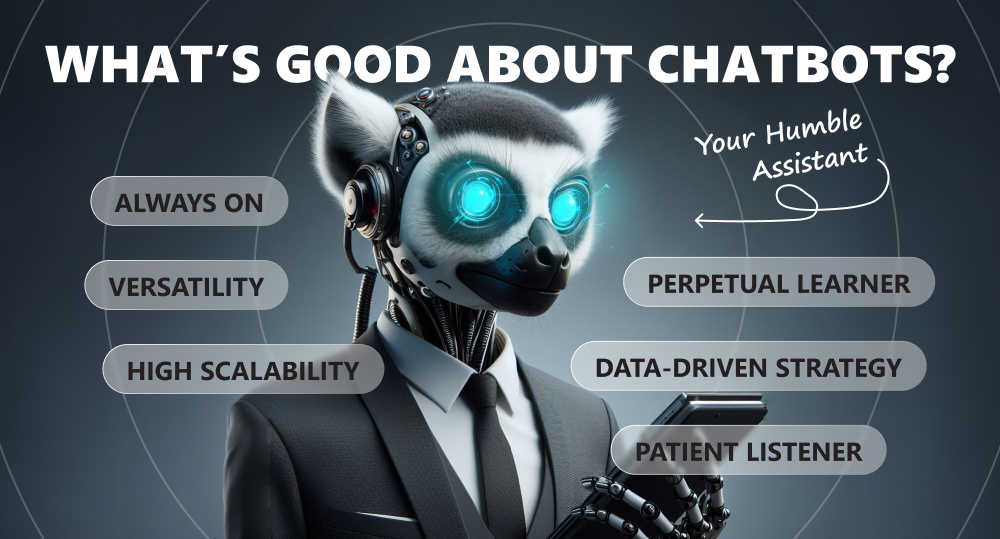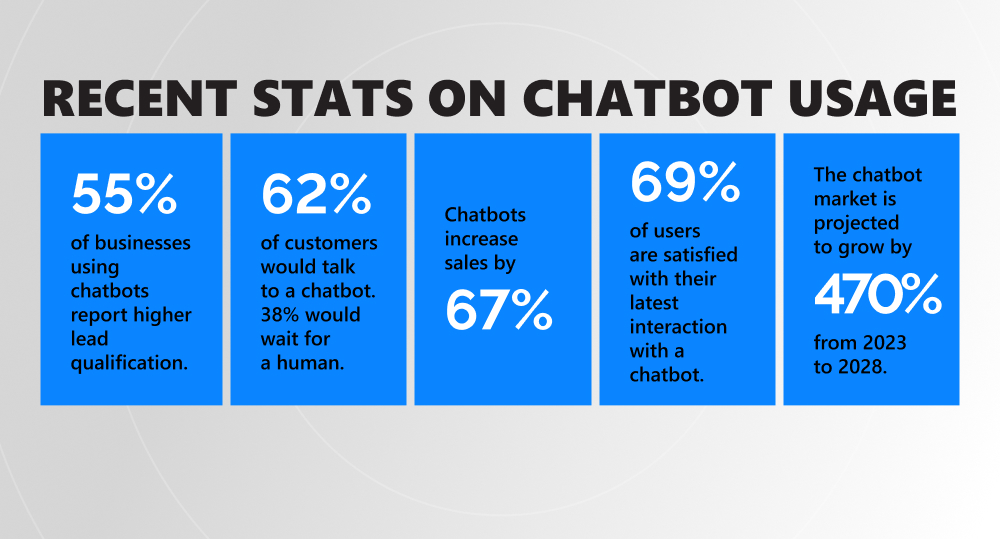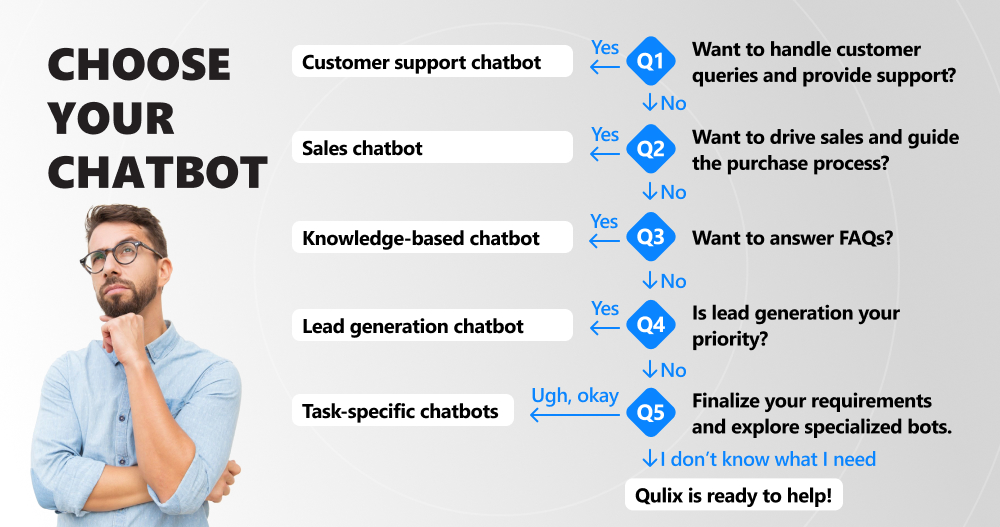How about using a chatbot for sales? Skeptical? Bet we can change your mind! Picture a shopper on your online store: poised to buy, their cart brimming with items — then vanish, like so many others, contributing to a staggering $111B–$136B in annual retail losses from abandoned carts. How can you thwart this scenario?
What if we tell you that the solution lies not in hiring more people but in making them smarter? This is where AI-powered chatbots come into play — digital helpers that swoop in when customers waver, offering tailored support and ensuring more carts make it through to check out. In this article, we’ll explore how sales chatbots can turn missed opportunities into revenue. Let's dive in!

written by:
Alexander Arabey
Director of Business Development
How about using a chatbot for sales? Skeptical? Bet we can change your mind! Picture a shopper on your online store: poised to buy, their cart brimming with items — then vanish, like so many others, contributing to a staggering $111B–$136B in annual retail losses from abandoned carts. How can you thwart this scenario?
What if we tell you that the solution lies not in hiring more people but in making them smarter? This is where AI-powered chatbots come into play — digital helpers that swoop in when customers waver, offering tailored support and ensuring more carts make it through to check out. In this article, we’ll explore how sales chatbots can turn missed opportunities into revenue. Let's dive in!
Contents
Challenge of Today: Uniting Sales and Marketing
Have you heard of the term “smarketing”? It's not just a buzzword; it's the merging of sales and marketing into a unified powerhouse, with the focus on:
- Targeting ideal prospects;
- Driving up conversions;
- Boosting sales performance.
Yet, the question remains: how many businesses can truly claim they've achieved this synergy within their walls?
Should the Two Worlds Reconcile?
Recent HubSpot research reveals a stark reality: only 30% of sales professionals report full alignment between their marketing and sales teams. However, 61% of respondents recognize the growing significance of this synchronized work compared to the previous year. Have they seen any benefits so far? Yes! Companies that have successfully merged these two functions are reaping the rewards: a 107% higher probability of achieving annual targets.
Despite the obvious perks, many businesses are still struggling to keep their sales and marketing departments operating in sync. The challenges are multifaceted, from communication barriers to utilizing separate data systems. The outcome? Wasted resources, uncoordinated messaging, along with lost potential customers and their money.
Is there any secret weapon to help your sales funnel? Luckily, yes. That's what we're discussing today: sales bots. By integrating them into your “smarketing” strategy, you can finally find the catalyst for aligning your teams, which is crucial for boosting sales and propelling your business forward.
How Can Retail Chatbots Help?
The days of patiently filling out forms or requesting quotes via email are long gone. Today's potential customer demands real-time interaction and instant solutions. When eCommerce businesses fail to meet these expectations, their clientele doesn't hesitate to switch to competitors who can deliver on the spot.
Such rivals are often those who have successfully extended the capabilities of human assistants from sales and marketing departments with artificial intelligence. That’s when sales chatbots enter the scene.
Why are they perfect assistants for sales reps and marketers? For one thing, they don't need to sleep. Working around the clock, bots provide a wealth of information about customer interactions and buying behavior. Even when dealing with clients who have a 10-hour time difference with your sales team. Second, they don't experience mood swings. You know, “it's not my day” moments and the like. They fuel engaging conversations and foster a consistent, personalized customer experience across all digital touchpoints — from websites to socials.
The final straw in chatbot mass adoption has been the emergence of large language models (LLMs) and the latest generative AI capabilities. These technologies empower sales chatbots to attract more leads while tracking the entire digital customer journey. The result? A significant uptick in sales opportunities and a revised business strategy where customer engagement is paramount.
Meet an AI Chatbot for Sales
“Good morning, Hazel! It's been a while since you bought coffee for your espresso machine. How about a refill? We have your favorite Brazilian coffee blend on sale for $20 a pack!”
Now, Hazel’s curiosity piqued. How did this heartless robot know her preferences? And how did it find out she has an espresso machine?
It's simple: she's talking to a conversational sales chat bot powered by AI. Its mission is to know precisely what the buyer likes and direct them to purchase exclusively from your store. How exactly does it do this? By capturing and analyzing customer data using NLP and ML algorithms. In this case, Hazel's purchase history and preferences.
AI Sales Chatbot, What Are You?
“Hello, dear human! I'm intelligent software designed to engage in real-time conversations with potential customers. My primary duty is personalized and automated support. As buyers navigate through the sales process, I swiftly attend to their inquiries. With the help of natural language processing (NLP) and machine learning (ML) algorithms, I strive to make users feel as if they’re interacting with a human agent.”
That's roughly the same response you can expect from the chatbot itself.
What are the strengths of this intelligent machine? They're numerous:
- Always on. An AI chatbot guarantees immediate assistance to potential customers, regardless of the hour or day. This round-the-clock care massively boosts lead-to-sale conversion rates.
- High scalability. Sales chatbots handle large volumes of customer queries all at once, maintaining peak efficiency.
- Versatility. Chatbots engage in a wide range of customer communications. They adapt to various scenarios, from answering basic FAQs to guiding users through their entire shopping journey.
- Perpetual learner. Powered by machine learning algorithms, online assistants analyze customer data and behavior patterns. With each interaction, they evolve and fine-tune their recommendations.
- Data-driven approach. A shopping chatbot gathers insights from dialogs with customers to refine sales and marketing tactics.
- Patient listener. Emotion? What emotion? Chatbots are truly cold-blooded in their essence. No matter how rude the customer is and how many swear words they write, these humble assistants will not take offense.
AI vs. Traditional Sales Chatbots
When a customer is chatting online with a bot, can they tell apart a classic chatbot or its advanced AI-driven counterpart? How do they differ? Let's break the distinctions down in a handy table:
Characteristic
Traditional Bot
Conversational AI
Interaction Style
Follows a predetermined algorithm and guidelines, delivering keyword-based answers.
More human-like dialogs thanks to NLP, ML, and NLU.
Flexibility
Limited, since responses are based on pre-set rules.
Adaptive and dynamic.
User Experience
Often static and repetitive. Can also seem too robotic and impersonal.
More human-like, engaging, and personalized thanks to understanding context and handling diverse queries.
Learning Ability
Developers can only train them explicitly.
Ongoing learning based on each user interaction.
Customization
Limited.
High: companies can tailor them to their specific business goals.
Use Cases
Basic tasks: answering FAQs, routing inquiries, and handling simple transactions.
Diverse: 24/7 customer support, lead qualification and generation, financial advice, etc.
Scalability
Limited: handle moderate volumes of requests.
Unlimited: efficiently manages large volumes of interactions.
Data Usage
Primarily use structured data and predefined responses.
Uses both structured and unstructured data, swiftly adapting to new requests.
Omnichannel Access
No, users have to start the conversation again on another device.
Yes, conversational solutions smoothly integrate into different environments and address requests.
Human Handoff
Often require manual handoffs to human sales reps to handle customer inquiries that are too complex.
Can address more complex tasks independently, reducing the need for human intervention.
Outstanding Retail Chatbot Examples
A sales chatbot is a must-have asset for modern commerce, you get the picture. But it's all bare-bones without vivid examples from everyday life, right? Below are the best sales chatbots you can interact with on the world's most prominent marketplaces:
Customer Support
1) LiA from Lidl
Lidl, a popular international supermarket chain, has been playing with AI since 2019, when it introduced a new employee, Facebook Messenger chatbot LiA. What's special about it?
- LiA is a 24/7 sales bot ready to assist new and existing customers of Lidl's physical stores;
- Users can interact with LiA for various purposes: store-related questions, shopping assistance, product information, etc.;
- If a visitor's needs extend beyond what LiA can handle, it redirects them to Lidl's customer care team during service hours.
2) Amazon Q for Customer Service
While Google has Bard, Microsoft has Copilot, and OpenAI boasts its famous ChatGPT, Amazon steps up with its own AI assistant — Q. Here are some facts about it:
- Unlike consumer-oriented chatbots, Q is built for customer care specialists. It assists them by recommending the most appropriate responses and actions based on analyzing conversation history and relevant company content.
- Q respects the existing identities, roles, and permissions within your organization. This guarantees personalized interactions while maintaining data security and privacy;
- Among its other job responsibilities are: document summarization, content creation (emails, articles), research, ticketing, addressing bugs, etc.
Personalized Recommendations
1) Sephora
As a global leader in the beauty retail sector, Sephora has been a trendsetter of digital innovation in customer care. In 2016, it added its chatbot into Kik, one of the popular mobile messaging apps. Sephora’s strategy with Kik is all about reaching young Gen-Z consumers and Millennials, as this app is highly popular among these demographics. What’s good about it:
- The Kik bot chats with users on beauty and makeup topics, providing reviews, makeup tips, and product recommendations;
- It prompts users to take quizzes about their beauty preferences, skin type, or favorite brands to make communication more personalized.
2) 1-800-Flowers' Gwyn
1-800-Flowers, a US-based company specializing in gift sales, has introduced their own sales chatbot Gwyn, short for “gifts when you need them”. It also belongs to the family of social media chatbots on Facebook Messenger. Gwyn offers the following features:
- Asking questions (about the occasion, sentiment, and preferences) to assess the giftee's wishes and tailor product suggestions;
- Supporting a voice chat via Amazon Alexa. All a user has to do is say “Alexa, ask 1-800-Flowers to send roses to my fiancée on Valentine's Day”;
- Helping customers track the delivery status.
3) Casper's Insomnobot-3000
Insomnobot-3000 is a chatbot created by Casper, a company that sells mattresses, bedding, and sleep accessories. Its mission is to help consumers pick the best mattress based on their sleep preferences. As a bonus, the chatbot keeps night owls and insomniacs company during restless nights with friendly messages. What about its key details?
- This bot is extra chatty between 11 pm and 5 am, precisely when sleep eludes many. It's designed to engage customers with lighthearted banter, providing a distraction during sleepless hours.
- If Insomnobot doesn’t magically cure insomnia or whisk users off to dreamland, then how does it boost sales? Conversation after conversation, sharing late-night worries — and the customer has complete trust in the brand. And when they need a new mattress or pillow, where does their mind wander? To Insomnobot, of course!
Tracking Orders
1) Pizza Hut
Available across Twitter, Amazon Alexa, and Facebook, the Pizza Hut chatbot makes it easier and faster to get a piping-hot pizza to eat while binge-watching Netflix. What does it bring to the table?
- By linking pizza lovers' social media accounts to their Pizza Hut profiles, the chatbot ensures swift delivery or pickup from the nearest location;
- Hosting a party and wondering when your pizza will arrive? The chatbot offers real-time order tracking.
2) Domino's Dom
Dom is accessible via Google Assistant, Facebook, Alexa, and (surprise-surprise!) SMS. Whether clients crave a classic pepperoni or a customized pizza, Dom streamlines the process of ordering that cheesy delight. Why users love it:
- Is your pizza being tossed, sauced, or en route? Just ask Dom using your keyboard or voice. Besides tracking, users can get estimated delivery time;
- The bot also answers FAQs and masters reordering;
- Consumers can link their social media accounts to Domino's profile to let the chatbot know them better.
Ready-Made Chatbot Solutions
Above, we discussed solutions that are already up and running. But what if you need software to quickly launch your own chatbot program? Here’s a concise table featuring some top providers in this field:
Service Provider
Reputation by TrustRadius
Price
Major Focus
Tidio
9.7/10
Free, paid plans start at $39/month
AI-powered customer service
Qualified
9.5/10
Starts at $3,500/month
Converting the most qualified leads into a pipeline
IBM watsonx Assistant
9.0/10
Free, paid plans start at $140/month
Delivering ongoing intelligent customer care
Intercom
8.7/10
Starts at $39 per seat/month
Customer engagement and support
WATI
8.7/10
Starts at $49/month
No-code chatbots for sales and support
Drift
8.2/10
Starts at $2,500/month
Revenue orchestration, conversational marketing and sales
*Check our AI development services and feel free to approach us with your ideas.
Upgrading Your Retail Strategy with Business Bots
Right, if you google “best chatbots”, you’ll see scores of ratings rife with shining examples. In reality, none of this matters unless you weigh the practical benefits of conversational AI. Let's get to the numbers:
What’s the Right Sales Chatbot for Your Brand?
As a business owner, you surely got inspired by the positive developments surrounding conversational AI-powered chatbots. But with so many options, how to decide which one is THE one? The diagram below provides clarity to help you:
Best Practices for Chatbot Integration
It's too naive to believe that implementing a chatbot is enough to lure crowds of delighted customers eager to buy everything in your store. To truly optimize chatbot integration, consider the following best practices:
Let Your Chatbot Introduce Itself
When launching a chatbot, ensure it introduces itself to users right from the start. This initial interaction sets expectations and clarifies to the user that they're interacting with a machine, not a human. Here are some effective ways to set things straight:
- Display a short notification in personalized welcome messages: “Hello! I'm [chatbot name], your virtual assistant. How can I help you today?”
- Use a bot-related vocabulary. Throughout the conversation, the chatbot should use phrases specific to its automated nature: “Sorry, I'm not human, but I'm here to help” or “Please bear with me as I gather the information you need.”
- Design a chatbot avatar. Visual cues effectively highlight the presence of a chatbot. Craft an avatar or icon for your helper to display during the conversation.
Make Your Sales Chatbot Humble
Gartner, Inc. predicts that by 2027, chatbots will become the primary customer service channel for nearly a quarter of organizations. While their capabilities keep evolving, let’s face the truth: today, they’re not quite our doppelgängers. Instead of striving for flawless human mimicry, consider building software that embraces its limitations. Here's what you can do:
- Recognize imperfection. A humble website chatbot knows its boundaries. Clearly communicate what it can and can't do. Users appreciate honesty, and realistic expectations prevent frustration.
- Keep it simple. Rather than burdening your sales chatbot with complex duties that may lead to errors, opt for basic responsibilities and simple repetitive tasks. This approach minimizes the chances of unsatisfactory results while providing a more reliable interaction with consumers.
- Human escalation. When faced with intricate issues, a chatbot should gracefully hand over the reins to a human. After all, some matters require that personal touch.
Use Conversational Flows to Your Advantage
Conversational flows are great marketing tools for guiding users through pre-defined steps, ensuring they reach the desired outcome. This helps prevent your sales chatbot from getting stuck or providing irrelevant responses. For instance, when a person asks about product pricing, AI can gather essential details like their location and product preferences. Based on their answers, it delivers accurate and tailored pricing information.
Such flows are a treasure trove for collecting consumer data for your BI needs. How does this work? By strategically incorporating specific questions and prompts into a web chat, you can collect valuable customer information. And then you can use this data to personalize experiences, offer targeted recommendations, and even shape future marketing strategies to generate leads and optimize sales processes.
Note: while structure is crucial, leave ample room for user input and flexibility. Strike a balance between guidance and freedom to create an experience when users feel heard.
Keep Humans Close
While chatbots excel at handling routine queries and providing quick solutions for more customers, there are scenarios where clients require personalized assistance beyond a virtual mind. In such cases, a smooth handoff process to a human operator becomes a must. Here's how to achieve it:
- Create chatbots that recognize when a conversation requires human intervention. Use NLP algorithms that detect frustration or confusion in customer messages, automatically transferring the chat to a live agent.
- Add a “Talk to a Live Agent” button to the chatbot interface.
- Prioritize efficient and timely communication between virtual and human professionals. Live agents should have easy access to chatbot transcripts, understand the client's story, and seamlessly continue the dialogue. Customer relationship (CRM) systems can help facilitate this process.
Stick to the Maintenance Routine
As technology and user preferences change, businesses should regularly review and update their sales chatbots to keep them relevant and effective. This may involve adding new features, integrating with relevant systems and platforms, or addressing any emerging issues.
Measuring the Success of Your Retail Chatbot
A retail business? Got it. A team of human agents? Check. A chatbot for rapid responses? On site. Great! What's next?
Well, now it’s time to keep an eye on how cohesive your human-machine alliance is. Here's how:
- Conduct a survey. Reach out to your clients after their interactions with the chatbot. Ask them to leave feedback and rate their satisfaction. This will help you identify areas for improvement and enhance the overall customer experience.
- Track performance. Watch key metrics: the problem resolution rate, customer satisfaction, average response time, task completion and error rates. Fine-tune your assistant as needed to optimize its performance.
- Monitor engagement metrics. Dive into engagement data. Analyze the number of unique users, frequency, and duration of interaction. Understand what queries or tasks customers initiate. This information will help you effectively fulfill customer requests.
- Count the money. The bottom line matters. Monitor how many customers complete transactions using a chatbot. Is it contributing to sales? To revenue goals? The numbers will tell the whole story.
Remember, patience is key. As with any process, results take time. But the payoff is worth it. Your chatbot will not only replace your customer care agent and finally unite sales and marketing departments. There's more — it'll become a virtual psychotherapist for your customers. With its help, they can spill their woes — whether it's about mowing the ever-growing grass or coping with their cat's wake-up calls at 4 am. In return, your sales chatbot will gently steer them toward purchasing sound-absorbing headphones or that shiny new lawnmower. Win-win!
No time for all the intricacies of chatbots and their artificial intelligence? Contact us, and we'll gather a team of experts to build your own sales bot and turn abandoned shopping carts into triumphant “Look what I bought!” moments.
FAQ
Chatbots are AI-based virtual assistants that interact with buyers, answer their questions, provide personalized recommendations, and guide them through the sales process. With technologies like NLP and ML, these virtual helpers understand client intentions and behaviors, resulting in an interactive customer experience. Here's how chatbots increase sales:
- Providing personalized recommendations for products and services;
- Sharing promotions, discounts, and special offers;
- Initiating conversations using proactive communication strategies;
- Answering product-related questions;
- Analyzing customer data, preferences, browsing behavior, and purchase history;
- Delivering exceptional round-the-clock customer support.
If you don't own a software development company, outsourcing to a seasoned team with expertise in conversational AI is the optimal solution. However, if you decide to venture into chatbot development on your own, follow these 6 steps to craft a user-friendly sales chatbot:
1) Know your customer. What is your target audience? What are their preferences and pain points? Figure this out and tailor your chatbot responses accordingly to personalize services and qualify leads.
2) Ensure an omnichannel experience. Make your online helper available across multiple platforms. Let chatbot users interact with it seamlessly over social media, websites, and messaging apps. Consistency across channels enhances the experience for both new and returning customers alike.
3) Endow the chatbot with personality. Consider a chatbot as a virtual assistant reflecting your brand’s voice. A friendly and accommodating tone can double user engagement.
4) Implement buttons with quick answers. This functionality reduces the cognitive load, enhances usability, and guides consumers through the conversation flow.
5) Add a “Talk to a Human” option. Include a prominent “Talk to a Human” button in a chat widget to connect with a live agent from your sales team. This builds trust and ensures a safety net for complex queries.
6) Play with analytics. Continuously track your sales chatbot's performance, monitor user interactions, and enhance their experience based on the data insights you get.
It's a company or service provider that specializes in developing chatbots for the retail industry and other spheres.
Like all the recent AI advances, chatbots are far from simple — they don’t just help you sell and make money. They are a true trigger for change in customer relationships. Here's how they are slowly but steadily revolutionizing the industry:
- Hyper-personalization: a sales chatbot will not only know about a customer's past purchases but also predict their future needs based on context and trends;
- Omnichannel experience: clients will be able to start a conversation on one platform and keep it going on another without any disruption;
- Advanced NLP: shopping chatbots will become more conversational and contextualized. They’ll understand nuances, emotions, and intentions better.
- Visual search integration: bots will evolve to process visual queries. Users will be able to upload images of products they like, and chatbots will find similar items.
- Automated inventory management: chatbots will forecast demand, optimize inventory, and prevent stockouts.

Contacts
Feel free to get in touch with us! Use this contact form for an ASAP response.
Call us at +44 151 528 8015
E-mail us at request@qulix.com

